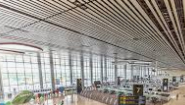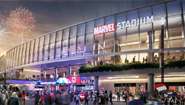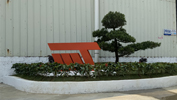The Longevity of Aluminum Panel Colors: Features and Benefits
Author:Jayminton Time:2024-08-12

aluminum panels have become a popular choice in modern architecture and design due to their remarkable durability and aesthetic appeal. One of the standout features of aluminum panels is their ability to retain color over extended periods. This characteristic makes them an excellent option for various applications where long-lasting visual appeal is essential. Here’s an exploration of why aluminum panel colors last so long and the features that contribute to their longevity.
1. Advanced Coating Techniques
Aluminum panels are often treated with advanced coating techniques that enhance their color durability. The two most common methods are anodizing and powder coating.
Anodizing: This electrochemical process forms a protective oxide layer on the aluminum surface. This layer not only enhances corrosion resistance but also helps lock in color, making it less susceptible to fading. Anodized aluminum can maintain its color integrity for decades, even in harsh environments such as coastal areas with high salt exposure.
Powder Coating: In this method, a dry powder is applied to the aluminum surface and then cured under heat. The result is a smooth, durable finish that resists chipping, scratching, and fading. High-quality powder coatings can maintain their color for 10 to 20 years, depending on the formulation and environmental conditions.
2. Natural Corrosion Resistance
Aluminum itself is highly resistant to corrosion due to its natural oxide layer. This built-in protection means that the underlying metal is less likely to degrade, which in turn helps preserve the color applied to the surface. Unlike other metals that might rust or corrode, aluminum panels remain robust and retain their appearance over time.
3. UV Resistance
Color fading is often caused by prolonged exposure to ultraviolet (UV) rays from the sun. Modern aluminum panel coatings are formulated to be UV-resistant, ensuring that colors do not deteriorate or shift significantly even with extended exposure to sunlight. This feature is particularly beneficial for exterior applications where panels are subject to constant sunlight.
4. Minimal Maintenance
One of the advantages of aluminum panels is that they require minimal maintenance to keep their color intact. Routine cleaning with mild soap and water can remove dirt and pollutants that may dull the surface. Regular maintenance helps prevent buildup that could affect the panel's appearance, ensuring that the color remains vibrant for years.
5. Environmental Resilience
Aluminum panels are designed to withstand a variety of environmental conditions, including extreme temperatures, humidity, and pollutants. This resilience means that the color coating is less likely to degrade due to environmental stressors. Whether used in urban, coastal, or rural settings, aluminum panels can maintain their visual appeal.
6. Aesthetic Flexibility
Aluminum panels offer a wide range of color options and finishes, including metallic, matte, and gloss. This versatility allows for customization that can enhance the architectural design while ensuring that the chosen color remains true and vibrant over time. The ability to choose from various finishes also means that the longevity of the color can be tailored to specific aesthetic and functional requirements.
Conclusion
The longevity of aluminum panel colors is a testament to the advanced technology and inherent properties of the material. Through sophisticated coating techniques, natural corrosion resistance, UV protection, minimal maintenance requirements, and environmental resilience, aluminum panels offer an attractive and enduring solution for various design and architectural needs. Whether used in residential, commercial, or industrial settings, aluminum panels stand out for their ability to retain color and maintain visual appeal, making them a reliable choice for long-term applications.

 S1 Clip-in Metal ceiling System
S1 Clip-in Metal ceiling System JMT-L4.2 U-Baffle System
JMT-L4.2 U-Baffle System JMT Aluminum Wall Cladding
JMT Aluminum Wall Cladding Aluminum Honeycomb Panel
Aluminum Honeycomb Panel Air-Condenser Cover
Air-Condenser Cover Metal Heat Cover
Metal Heat Cover Singapore Changi Airport T2 Arrival
Singapore Changi Airport T2 Arrival Australia Marvrl Stadium City Edge
Australia Marvrl Stadium City Edge Enterprise Information Announcement
Enterprise Information Announcement Construction Industry Solutions
Construction Industry Solutions About Jayminton
About Jayminton Contact US
Contact US